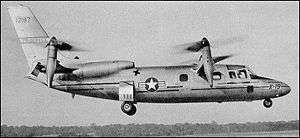Curtiss-Wright X-19
| X-19 | |
|---|---|
 | |
| X-19 in hovering flight | |
| Role | Experimental VTOL Transporter |
| Manufacturer | Curtiss-Wright |
| First flight | November 1963 |
| Status | Cancelled |
| Number built | 2 |
|
| |
The Curtiss-Wright X-19 was an American experimental VTOL tiltrotor airplane of the early 1960s.
Design and development
In March 1960 the Curtiss-Wright Corporation developed the X-100, a prototype for a new, vertical takeoff transport aircraft. The X-100 had a single turboshaft engine, which propelled two tilting-rotors, while at the tail swivelling nozzles used the engine's exhaust gases to give additional control for hovering or slow flight.
From the X-100 Curtiss-Wright developed the larger X-200, of which the United States Air Force ordered two prototypes designated the X-19A.
The X-19 had high-mounted tandem wings. Each wing mounted two 13 ft (4.0 m) propellers that could be rotated through 90 degrees allowing the aircraft to take off and land like a helicopter. The propellers were driven by twin Avco Lycoming T55-L-5 turboshaft engines mounted in the fuselage.[1]
Operational history
The first flight of the X-19 took place in November 1963 (other sources give 26 June 1964). It was intended that the X-19 would be developed into a VTOL transport aircraft. However the first X-19 was destroyed in a crash on 25 August 1965, and the program was subsequently cancelled.
The second prototype is currently being stored in the restoration facilities at the National Museum of the United States Air Force in Dayton, Ohio.[2]
Specifications (X-19)

General characteristics
- Crew: 2
- Payload: 1,200 lb (544 kg)
- Length: 42.08 ft (12.83 m)
- Wingspan: 19.5 ft (forward) / 21.5 ft (aft) (5.94 m / 6.55 m)
- Height: 17.17 ft (5.2 m)
- Empty weight: 9,775 lb (4,425 kg)
- Max. takeoff weight: 13,660 lb (6,196 kg)
- Powerplant: 2 × Avco Lycoming T55-L-5 turboshaft, 2,200 shp (1,640 kW) each
Performance
- Maximum speed: 454 mph (730 km/h)
- Range: 325 miles (523 km)
See also
- Aircraft of comparable role, configuration and era
References
- Notes
- ↑ Apostolo 1984, p. 63.
- ↑ "Aircraft list." Archived December 3, 2008, at the Wayback Machine. National Museum of the United States Air Force. Retrieved: 17 June 2012.
- Bibliography
- Apostolo, Giorgio. The Illustrated Encyclopedia of Helicopters. New York: Bonanza Books, 1984. ISBN 0-517-439352.
External links
| Wikimedia Commons has media related to Curtiss-Wright X-19. |